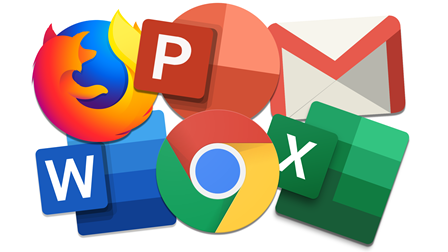There are two types of software. There are System Software and Application Software. System software aids the user
and the hardware to function and interact with each other. Application software that helps the end user tasks.
Application software other names are end user programs, productivity programmes, Applications, and System.
1.Application Softwares
Types of application Softwares are Desktop Application (Software), Web Application (Website), Embedded
Application (Electronic Device), and Mobile Application(Mobile Apps).
•Desktop application
Desktop applications run on a local computer. It includes all necessary functionality and does not need to be
connected to a network. This type of application will install on each device.
Example: Microsoft Office, Paint, Notepad, Calculator, Audio Player, Video Player, Browser, Photoshop,
Tally, Libre Office, Gedit, Terminal.
•Web Applications
Web application stored on a server. It can be accessed by users via URL(
https://www.adscbe.com). Users need a browser to access the web
applications.
Example: facebook, Twitter, Gmail, Yahoo mail, Website(Govt, Educational Institutions, Blogs, Social Media,
Bank, News, Online Examination, Hospitals).
•Embedded Application
Embedded Application that control and manage hardware devices.
Example: Calculator, TV Remote, AC Remote, Washing Machine, Radio, Television, Mobile, Induction Stove,
Smart Watch, Traffic Signals, Printers, Automatic door sensors .
•Mobile Applications
Mobile application runs on a mobile device.
Example : Calculator, Radio, Phone, Gallery, SMS, Games, Audio Player, Video Player, Clock, Camera, Flash
Light, Browsers, Bank, Mobile network, Social Media, Docs, Sheets, .
2.System software
System software aids the user and the hardware to function and interact with each other. It is a software to
manage computer hardware behavior. It provides basic functionalities that are required by the user. System
software is an intermediary between the user and the hardware. When you first turn on the computer, it is the
system software that gets initialized and gets loaded in the memory of the system. The system software runs in
the background and is not used by the end-users. This is the reason why system software is also known as
‘low-level software’.
Some common system software examples are: Operating System, Device Drivers, Firmware, utility, Programming
language Translators.
3•Operating System
It is the most prominent example of System Software. It is a collection of software that handles resources and
provides general services for the other applications that run over them. Although each Operating System is
different, most of them provide a Graphical User Interface through which a user can manage the files and folders
and perform other tasks. Every device, whether a desktop, laptop or mobile phone requires an operating system to
provide the basic functionality to it. As an OS essentially determines how a user interacts with the system,
therefore many users prefer to use one specific OS for their device. There are various types of operating
systems such as real-time, embedded, distributed, multi user, single-user, internet, mobile, and many more. It
is important to consider the hardware specifications before choosing an operating system.
Examples : Microsoft Windows, Ubuntu, Android, CentOS, iOS, Linux, Mac OS
•Device Drivers
It is a type of software that controls particular hardware which is attached to the system. Hardware devices
that need a driver to connect to a system include displays, sound cards, printers, mice and hard disks. Further,
there are two types of device drivers: Kernel Device Drivers and User Device Drivers.
Examples of device drivers: BIOS Driver, Display Drivers, Motherboard Drivers, Printer Drivers, ROM Drivers,
Sound card Drivers, USB Drivers, VGA Drivers, Virtual Device Drivers.
•Firmware
Firmware is the permanent software that is embedded into a read-only memory. It is a set of instructions
permanently stored on a hardware device. It provides essential information regarding how the device interacts
with other hardware. Firmware can be considered as ‘semi-permanent’ as it remains permanent unless it is updated
using a firmware updater.
Some examples of firmware are: BIOS, Computer Peripherals, Consumer Applications, Embedded Systems, UEFI
•Programming Language Translators
These are mediator programs on which software programs rely to translate high-level language code to simpler
machine-level code.
Examples of Programming Language Translators are Interpreter, Compiler and Assemblers.
•Utility
Utility software is designed to aid in analyzing, optimizing, configuring and maintaining a computer system. It
supports the computer infrastructure. This software focuses on how an OS functions and then accordingly it
decides its trajectory to smoothen the functioning of the system. Softwares like antiviruses, disk cleanup &
management tools, compression tools, defragmenters, etc are all utility tools.
Some examples of utility tools are: Antivirus, CCleaner, Windows File Explorer, WinRAR, WinZip.
